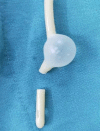Diagnosis and treatment of cervical incompetence combined with intrauterine adhesions
- PMID: 32175348
- PMCID: PMC7049037
- DOI: 10.21037/atm.2019.12.148
Diagnosis and treatment of cervical incompetence combined with intrauterine adhesions
Abstract
Background: Cervical insufficiency (CI) with concomitant intrauterine adhesions (IUAs) is a common clinical phenomenon among CI patients. But there are neither published reports regarding the difference in diagnosis and treatment of such patients compared to those with CI only, nor any report about their prognosis. This study aimed to preliminary the alteration in diagnostic and curative aspects of these patients, so as to provide a certain reference for the clinical management of such conditions.
Methods: Ten patients with CI combined with moderate to severe IUAs were diagnosed, treated and followed up at the Third Xiangya Hospital of Central South University from September 2017 to August 2019, their medical records and the pregnancy outcomes were retrospectively analyzed.
Results: All 10 patients had a previous history of typical painless cervical dilatation during the second trimester. All patients were moderate to severer IUAs, and the mean AFS score of IUAs was 9.80±1.08 (range, 8 to 12). Preoperatively, in 6 patients, the No. 7 Hegar dilator was able to pass through the internal cervical os before surgery without resistance. In the other 4 patients, the Hegar dilator could not be inserted before surgery due to the adhesions of the cervical canal and the lower uterine segment; the diagnoses of these patients were further confirmed at 3 months after hysteroscopic adhesiolysis (HA) when the No. 7 Hegar dilator was able to pass through the internal cervical os without resistance. There were 9 patients underwent pre-pregnancy laparoscopic cervical cerclage after HA. The remaining 1 patient exceptionally underwent laparoscopic cervical cerclage prior to HA, as the cervix was too loose to retain and be treated with an intrauterine device (IUD) or distended Foley's catheter balloon; which essentially prevent postoperative adhesion reformation. The patients were followed-up for 3 months to 2 years. The pregnancy rate was 60%, and the live birth rate was 100%.
Conclusions: In patients with CI and concomitant cervical or lower uterine segment IUAs, it is necessary to separate the adhesion prior to evaluating the cervical competency with the No. 7 Hegar dilator, to confirm the diagnosis. However, when the cervix is too loose, laparoscopic cervical cerclage is exceptionally carried out first and then IUAs is treated. Pre-pregnancy laparoscopic cervical cerclage has a good prognosis in patients with CI complicated by moderate to severe IUAs.
Keywords: Cervical incompetence (CI); diagnosis; intrauterine adhesions (IUAs); laparoscopic cervical cerclage; live birth rate.
2020 Annals of Translational Medicine. All rights reserved.
Conflict of interest statement
Conflicts of Interest: The authors have no conflicts of interest to declare.
Figures
Comment in
-
Management of concomitant cervical insufficiency and intrauterine adhesions.Ann Transl Med. 2020 Apr;8(8):526. doi: 10.21037/atm.2020.03.137. Ann Transl Med. 2020. PMID: 32411749 Free PMC article. No abstract available.
-
Transabdominal cerclage (TAC) as a new tool for the treatment of cervical incompetence (CI).Ann Transl Med. 2020 May;8(9):571. doi: 10.21037/atm-2020-78. Ann Transl Med. 2020. PMID: 32566598 Free PMC article. No abstract available.
References
-
- American College of Obstetricians and Gynecologists ACOG Practice Bulletin No.142: Cerclage for the management of cervical insufficiency. Obstet Gynecol 2014;123:372-9. 10.1097/01.AOG.0000443276.68274.cc - DOI - PubMed
LinkOut - more resources
Full Text Sources


